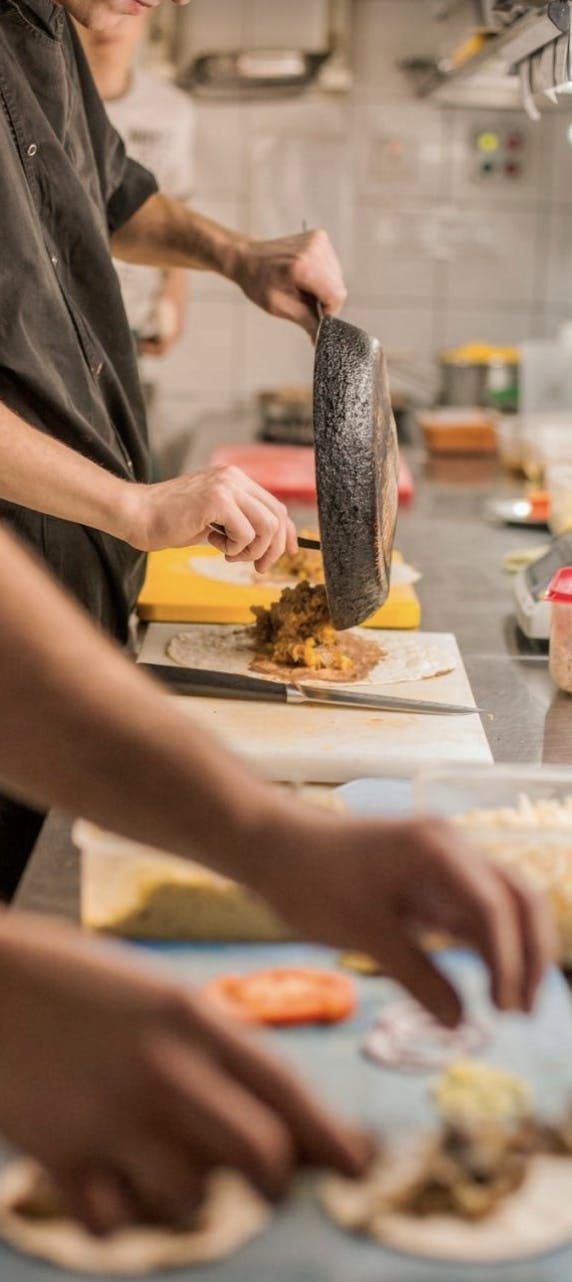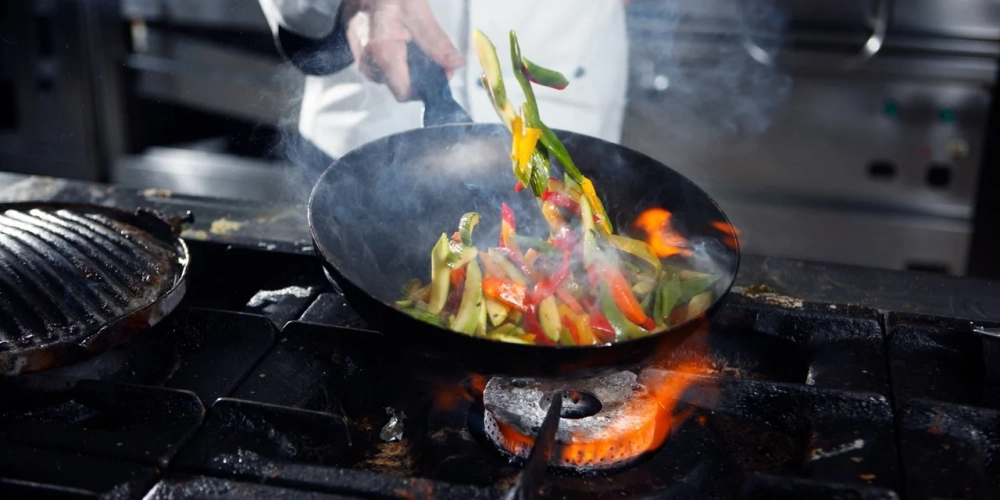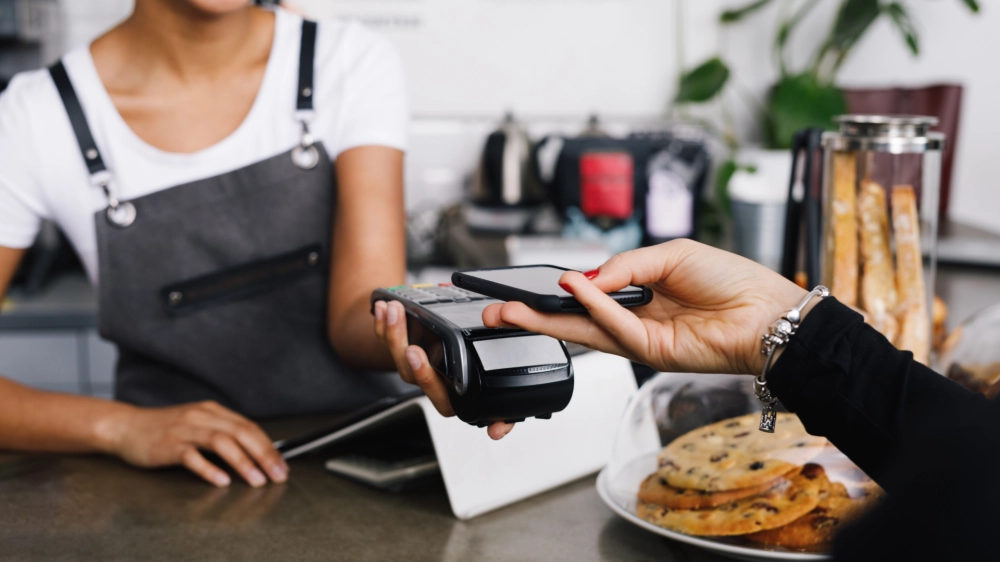How to Open a Restaurant with Low Risk and Low Capital
Table of Contents
CloudKitchens
How many tacos can be delivered from a 1000sqft restaurant?
The same amount as a 200sqft ghost kitchen.
You may be thinking it’s impossible to open a restaurant with low risk and low capital. Here’s why that’s a myth.
With the new year just around the corner, you’re probably wondering if opening a new restaurant is the best move for you and your business. With coronavirus stay-at-home measures and the shift to delivery, it may seem almost impossible to learn how to start a restaurant.
About 60% of customers in the United States order delivery once a week.1 And this percentage is continuing to increase at a rapid rate. It’s becoming clearer that brick-and-mortar restaurants are missing the technology and infrastructure needed to succeed in this delivery-first future. A typical restaurant just isn’t built for food service delivery.
Not only are today’s restaurants not built to meet the growing delivery demand, traditional food business establishments are also not very cost-effective.
You’re not only paying endless fees to your landlord, you’re also looking at paying top prices for a small piece of real estate on a busy street so you can generate more foot traffic. With rising shelter-in-place orders across the country, foot traffic is becoming less and less of a necessity.
Now that your customers are home more than they ever have been before, what was once foot traffic is now becoming online traffic, where hungry customers are searching and ordering for food on a variety of delivery apps. So while you’re paying top dollar for your brick-and-mortar, customers are choosing their restaurants based off of an online storefront, not a physical storefront. New trends are entering the restaurant market, causing an industry-wide shift to delivery.
To a restaurant owner, it’s a different playing field now with the demand for kitchens for rent, where visibility online has become more important than foot traffic.
There’s no question that 2020 has reshaped the restaurant industry. But that doesn’t mean this is the end of your dream of owning a successful restaurant business – it might just look different. With crisis comes opportunity, as they say.
There’s been a massive shift to ghost kitchens and virtual kitchens from many different forms such as commercial kitchens and commissary kitchens. But what is a ghost kitchen, and why use one? They’re optimized for takeout and delivery, rather than dine-in at a physical location. It’s a new model for running a restaurant that makes it possible for you to get into the game with low risk and low capital.
So while on the surface, it may feel like a hard time to start the restaurant concept you’ve been cooking up for years now, it may actually be the perfect time to test the idea without losing your life savings in the process. But let’s break that down a little further.
Why open a ghost kitchen?
Lower cost
With ghost kitchens, you only need a small upfront investment to get started with your commercial kitchen, whereas opening a brick-and-mortar location means you’re likely spending $500K or more just on a buildout of the space itself, not to mention securing restaurant insurance.2 With a much lower cost to get started, your risk is lower, too.
But it’s not just lower capital – the ongoing operational costs are lower too. Restaurant owners can cut down on rent since there’s no need to pay the high cost of a location with tons of foot traffic. In this case, your presence is online. And that makes ghost kitchens a more affordable route since they just need to be in a delivery hotspot, not the busiest street corner in town for dine-in traffic.
With a typical restaurant, you’d also need a large front-of-house team for dine-in guests. But with ghost kitchens, you only need as few as 3 to 5 back-of-house staff members total.
With lower real estate and labor costs, you’re running at optimal efficiency. Even further, when you partner with CloudKitchens, we supply the order runners, handoff staff, and more so there’s no need for additional fulfillment staff. You can just focus on making great food.
Fast and easy setup
Opening a brick-and-mortar location typically takes a year, if not more. Ghost kitchens only take about a month to be up and running. That’s a lot of time and money saved for a business owner.
At CloudKitchens, you’re set up with basic commercial kitchen equipment, like a three-compartment sink and hood, so you’ll need to bring the rest based on your specific food preparation and cuisine needs.
Also, everything’s online. So all you have to do is create your account within each delivery app, post your restaurant name, upload high-quality photos of your menu items, and list each menu item to start taking online orders. You’re able to reach more customers online without the need for a physical storefront.
Unlimited support
When you open your delivery-only restaurant with CloudKitchens, you have support every step of the way. You’ll have a customer success team cheering you on as you grow your delivery business. A typical restaurant kitchen doesn’t come with all the pieces of the operations puzzle, whereas a ghost kitchen does. All of the restaurant delivery services you need will be all in one place.
Your Customer Success Manager will be your dedicated expert and able to answer any questions you have about delivery. They’ll equip you with industry knowledge about delivery specific to your market, so you’re staying ahead of the competition.
They’ll also help you with anything from getting set up on delivery apps to optimizing your menu and ensuring your delivery-only kitchen is ready for business.
Access to key insights
Not only are ghost kitchens much faster and easier to set up, but you’re also able to leverage key insights to help you succeed in the delivery game. At CloudKitchens, you’re able to streamline orders on one tablet, which provides you access to consumer data all in one place.
You can easily stay organized by managing orders on one tablet and you’ll have access to customer data so you can cut back on wasted ingredients and focus on the menu items that sell the best.
Let’s say you recently opened your pizza joint within a ghost kitchen and you’re noticing week over week that your extra salad items just aren’t selling. Instead of stocking up on more products that will eventually go to waste and cost you more money, you can leverage that data to 86 items that aren’t working and focus on the best sellers. You’ll also be able to see when the highest volume of customers are ordering the most and shift your operating hours based on demand.
Room for creativity
As a passionate foodie, getting creative in the kitchen is one of the best parts of the business. But chances are you’ve held back from getting too creative because the risk of failing is just too big.
With ghost kitchens, you can easily experiment with different menu items and concepts until you’ve found what keeps your customers coming back for more. The low-risk nature of the model makes it easy to test and learn without spending too much time or money.

Wondering how to get started? Check out our 7-step restaurant business plan checklist
With lower costs, more flexibility, and an easy setup, are you ready to get that restaurant concept off the ground in a ghost kitchen?
We’ve laid out seven simple steps to follow when creating your business plan so you’re set up for success.
Step 1: Create a concept
When you’re creating your food business plan, you’ll first want to begin with a concept. What’s your mission statement? What value will you be bringing to your future customers? What’s the name of your concept?
You’ll want to start brainstorming what sets your future business apart from the rest and how you’ll keep your hungry customers coming back for more.
Step 2: Determine the goals
Next, you’ll want to determine your short and long-term goals for your business. You should focus on what matters most to you for your business and how you’ll set yourself up for success.
Step 3: Conduct market analysis
Once you’re confident about your business concept, you can move forward with your market analysis. This is where you’ll conduct market research to determine who your target market is and the competitive landscape.
This means determining the demographics of your target customers as well as looking at their consumer behavior. When do they typically order food? What menu items do they seem to order the most?
Once you’re able to answer these primary questions, you need to continue research to see what restaurants have already established a customer base in your target location and determine how you can tap into their market. This means looking at how they run their business… things like their prices, hours of operation, menu, and what differentiates them from the rest.
Knowing whether other restaurants in your intended market are delivery-only or dine-in will also help you better understand their business model and how they consistently bring in more customers.
When you see what works for your future competitors, this helps you better understand how you’ll enter the market and what you can do to crush your delivery game and stand out from the rest.
Step 4: Start planning the menu
Once you’ve gained a thorough understanding of your market, you’re ready to start the most important step which is developing your menu. Be sure to reference the market analysis you conducted earlier to determine what dishes are performing best based on your target market and delivery location. You will also want to keep in mind which menu items package and travel well. How your menu items arrive to the customer when delivered is crucial for customer satisfaction.
Next, you’ll conduct a cost analysis to determine what prices you should be setting for each menu item. It’s crucial to review market data to see average menu item prices for the cuisine type and concept you are trying to implement. This will help you narrow down your menu to ensure you’re seeing a return on each menu item.
Take a look at the most popular delivery apps like Uber Eats, Grubhub, and DoorDash to get a feel for what your online menu should look like. Digital presence means everything in the online delivery game so you’ll want to ensure your menu is consistently updated with prices, accurate descriptions, and high-quality photos.
You’ll finish this step with a mockup design of what your menu will look like. Remember, this menu will represent your business online. It will be displayed on multiple delivery apps and Google, so you want it to always be up-to-date and easy to navigate.
The easiest way to evaluate your online menu is to view it as a potential customer. If you saw this, would it be easy to understand what the prices are and what each menu item looks like? The easier your menu is to navigate for the customer, the easier it will be for them to purchase what they want (and drive more sales).
Customer satisfaction also plays a key role in your online visibility. The better the food quality and how your menu looks, the happier your customers will be, meaning better online reviews and a boost in your online ranking.
Step 5: Choose the right location
Once your menu is ready, you’ll need to lock in a ghost kitchen location.
CloudKitchens provides space in hot zones for delivery, meaning you’re able to reach a higher volume of potential customers because we’ve already done the homework on where the best locations are.
If you’re ready to check one out in person, just schedule a tour.
Once you’ve determined the best facility and location for your delivery business, you’ll need to decide the team of employees you will have to ensure your restaurant is up and running without a hitch.
Step 6: Plan for hiring employees
With a ghost kitchen, you only need a few hands on deck to get cooking. These are kitchens built for online delivery so all you need to do is supply a small team of as few as 3 to 5 back-of-house members to start cooking.
When it comes to hiring and scheduling shifts for employees, you’ll want to reference your market analysis to determine what the optimal times for delivery are based on your market and menu. This will help cut unnecessary labor costs when there’s downtime between peak demand periods.
Once you have your back-of-house team ready, it’s time to move on to the final step which is implementing your marketing strategy.
Step 7: Build a marketing strategy
You’ve already conducted a market analysis, but you’ll need to determine which marketing offers and promotions you want to use to attract new and existing customers online.
You can review your competitive set to see what offers they’re running and how their brand is represented on each online delivery app.
On delivery apps such as Uber Eats, Doordash, and Grubhub, you can easily implement promotions within each such as Spend More Save More, or Free Delivery. This gives you flexibility based on what you’d like to offer and what you think will generate the most orders.
Through understanding when your target market is online and ordering, you can also schedule social media posts to go live during those peak periods and have them coincide with any promotions you’re running on delivery apps.
Let’s say you’re running a promotion for Free Delivery on Uber Eats. You can maximize your online reach by scheduling social media posts coinciding with your Uber Eats promotion to drive more traffic to your online menu.
That’s it. Once you’ve fine-tuned your business plan, you’re ready to start growing your restaurant online.
As we said – with crisis comes opportunity. Opening a restaurant is easier than you think.
Explore ghost kitchen locations across the US:
- Ghost kitchens in San Francisco
- Ghost kitchens in LA
- Ghost kitchens in NYC
- Ghost Kitchens in Toronto
- Ghost Kitchens in Atlanta
- Ghost Kitchens in Dallas
- Ghost Kitchens in Chicago
- Ghost Kitchens in Denver
- Ghost Kitchens in Miami
| DISCLAIMER: This information is provided for general informational purposes only and the content does not constitute an endorsement. CloudKitchens does not warrant the accuracy or completeness of any information, text, images/graphics, links, or other content contained within the blog content. We recommend that you consult with financial, legal, and business professionals for advice specific to your situation. |
Sources:
https://upserve.com/restaurant-insider/online-ordering-statistics/
https://yourbusiness.azcentral.com/national-average-size-restaurant-kitchen-29446.html https://pos.toasttab.com/blog/on-the-line/how-much-does-it-cost-to-open-a-restaurant
More insights & stories
There’s more where that came from.
Get in the know and check out our additional insights




